Medical expert of the article
New publications
Spider bites: what to do, first aid
Last reviewed: 07.07.2025

All iLive content is medically reviewed or fact checked to ensure as much factual accuracy as possible.
We have strict sourcing guidelines and only link to reputable media sites, academic research institutions and, whenever possible, medically peer reviewed studies. Note that the numbers in parentheses ([1], [2], etc.) are clickable links to these studies.
If you feel that any of our content is inaccurate, out-of-date, or otherwise questionable, please select it and press Ctrl + Enter.
A spider bite is something that can happen to summer residents, lovers of agriculture and gardening, as well as tourists and fans of outdoor recreation. Considering that the spring-summer cottage and tourist, hiking season is already open, the risk of suffering from a spider bite increases.
Spiders are the most ancient inhabitants of the planet, according to arachnologists, these arthropods appeared on Earth more than 400 million years ago. Today, there are about 40 thousand species of spiders, but only a few of them pose a danger to humans.
Almost all of the 30,000 species of spiders are venomous. However, most have fangs that are too short or brittle to penetrate skin. Serious systemic reactions are most common with bites from brown spiders [e.g., the brown recluse (Loxosceles) and black widow spiders (Latrodectus). The most dangerous bites are from Latrodectus mactans, the female black widow spider. Brown widow spiders are found in the mid-, western, southern, and central parts of the United States. They are rarely found in coastal and Canadian border states, except when smuggled in clothing or luggage. Black widow spiders are found throughout the United States. Several venomous species (e.g., Pamphobeteus, Cupiennius, Phoneutria) are not native to the United States, but are imported as rare pets.
The venoms of only a few spiders have been studied in detail. The most important effects of the venom are necrosis (brown and some house spiders) and neurotoxicity (black widow spider). The most toxic component of the black widow spider venom is thought to be a peptide that disrupts neuromuscular transmission. In the brown spider, the specific fraction of the venom that produces the characteristic necrotic damage has not been identified.
These types of arthropods are usually found in southern regions with a warm climate, they hide in places where people rarely go or simply where they can hide - in woodpiles, sheds, storage rooms, in crevices in the ground, among dry last year's grass. A spider bite is not an attack, but rather a defense from dangerous arthropods. For a person, a spider bite is a threat in terms of the direct effect of the poison, the manifestation of an allergic reaction to the introduction of a poisonous substance or infection of the wound after the bite.
Bites of poisonous spiders
It should be noted that any spider is a priori poisonous, since arachnids are predators and poison serves as a weapon for them, a way to get food, and also to defend themselves. Bites from poisonous spiders can be both deadly and simply unpleasant, but not threatening troubles. Almost all spiders have glands that secrete poison, which is conventionally divided into two types - hemolytic and neurotoxic. The most common spiders are those that secrete neurotoxins that paralyze the nervous system of the intended victim. Small spiders are not dangerous, since they are simply not able to damage human skin or animal skin, and the secreted poisonous substance will be too small to cause any complications. Bites from poisonous spiders of larger sizes can really be dangerous, especially if we are talking about a black widow or a brown recluse spider.
 [ 1 ]
[ 1 ]
What does a spider bite look like?
How to distinguish a simple scratch, which is not uncommon during gardening or hiking, from an arthropod bite? First of all, you need to know what a spider bite looks like and feels like:
- The first sensation is similar to a prick from a thin needle. Quite often, a person does not feel the bite at all.
- A small white spot (not larger than a five-kopeck coin) immediately forms at the site of the injury. The edges of the white spot are most often pink or red.
- After a few minutes (5 to 20) the symptoms begin to increase.
- Sudden muscle pain appears, cramps are possible.
- The face becomes very red and may swell.
What a spider bite looks like depending on its type:
- The bite of a tarantula and some other species looks like a small spherical spot (swelling). The skin around the puncture is swollen like a blister, the color is usually pale with reddish edges. In an hour or two, the blister can burst, turning into a wound. If the blister is not treated in time, it can transform into an erosive wound, that is, an ulcer, within an hour.
- The bite of the brown recluse spider also looks like a blister surrounded by an irregularly shaped bluish-purple, white and red border. Often, such a bite is called a "bull's eye" or "target", so similar is the pattern of damage to these images. The blister quickly increases in size, bursts and forms a wound that is more like an ulcer.
- The bite of a black widow spider is usually not visually noticeable at all. It feels like a flea or mosquito bite, and a microscopic red spot may appear, which disappears literally before your eyes.
Symptoms of a spider bite
Brown spider bites are most common in the United States. Some bites are initially painless, but pain, severe and involving the entire limb, develops within 30 to 60 minutes in all cases. Erythema and ecchymosis appear at the bite site, and itching may occur. Itching may also spread over the entire body. Often surrounded by an irregular area of ecchymosis, a central blister (a "bull's eye") forms at the bite site. The lesion may resemble pyoderma gangrenosum. The central blister becomes large, fills with blood, ruptures, and leaves an ulcer on which a black scab forms; it eventually sloughs off. Most bites leave a small scar, but some may leave a deep defect involving muscle. Loxoscelism (a systemic syndrome caused by the venom) is not detected until 24 to 72 hours after the bite, but not always. All previously reported fatal cases were caused by systemic effects of the poison (e.g. fever, chills, nausea and vomiting, arthralgia, myalgia, rash, convulsions, arterial hypotension, disseminated intravascular coagulation, thrombocytopenia, hemolysis, renal failure).
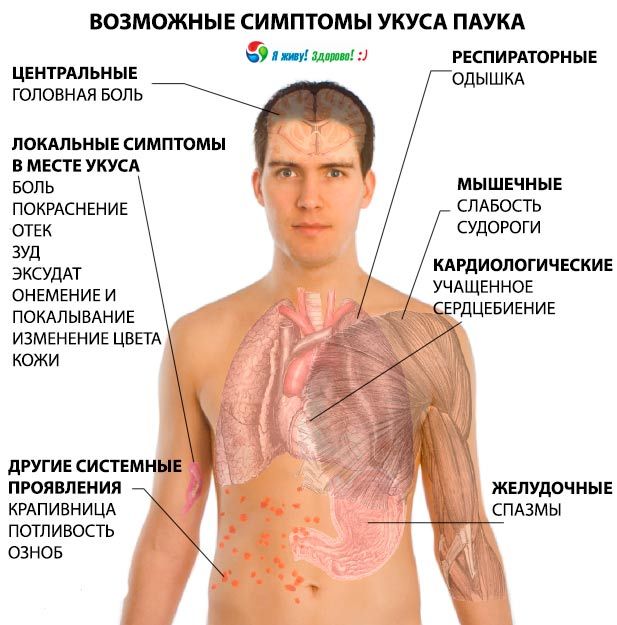
The symptoms of a spider bite can be varied. If you know for sure, or even just suspect that a bite has occurred, and cannot differentiate it from an insect bite, it is better to play it safe and consult a doctor. Also, specialist help (usually emergency) is needed when the following symptoms of a spider bite appear:
- Around the bite site, a purple, bluish, speckled area formed, surrounded by a white and then red ring. In toxicology practice, this symptom was called "red, white, blue." This is a clear sign of an attack by a poisonous recluse spider.
- The body of the affected person becomes covered with a rash.
- Muscle spasms appear, even to the point of cramps, both in the legs and arms.
- There is a feeling of numbness at the site of the injury. The bite site becomes slightly denser to the touch. This most often indicates a karakurt attack.
- Symptoms of a spider bite, which manifest as pain in the right hypochondrium, are also a clear sign of a black widow bite. Such pain is very similar to an attack of an inflamed appendix.
- The headache increases and the temperature rises sharply.
- Accompanied by aching joints and general weakness.
- Urine may take on an uncharacteristic color, most often pink or even red.
Black widow bites
The black widow is the name given to the female karakurt. The female is usually noticeably larger in size than the male, and it was not by chance that she was called a black widow - after mating, the female mercilessly devours the arachnid in love.
The bite of a black widow spider is considered one of the most dangerous, sometimes fatal, of all the injuries that a person can receive from arthropods. The wound is almost invisible, it feels like a light prick, and the symptoms do not appear immediately - after a couple of hours. Black widow bites usually cause an immediate sensation of a sharp bite.
Within an hour, poisoning may cause local pain, sweating, erythema, and piloerection at the site of the bite. The pain may be either dull or sharp and may not correspond to the clinical signs. Latrodectism is a systemic syndrome caused by the neurotoxic components of the venom and is characterized by agitation, anxiety, sweating, headache, dizziness, nausea and vomiting, hypertension, hypersalivation, general weakness, widespread erythematous rash, itching, ptosis, swelling of the eyelids and extremities, difficulty breathing, increased skin temperature in the affected area, as well as painful spasms and tension in the muscles of the abdomen, shoulders, chest, and back. Abdominal pain may be severe and similar to that of appendicitis. Latrodectism is rare and most often develops in children or elderly patients with chronic diseases. Fatal outcomes are very rare. Symptoms subside within 1-3 days, but residual seizures, paresthesia, anxiety and weakness may persist for several weeks or months.
The most effective way to neutralize a black widow spider bite is considered to be a special serum, which is not always available, especially in the first hours after the attack.
 [ 2 ]
[ 2 ]
Tarantula bites
Tarantulas are strongly associated with poisonous spiders, but this idea is somewhat exaggerated. Indeed, a tarantula spider bite can cause some painful symptoms, but fatalities are extremely rare and are most often associated with a combination of other internal pathologies.
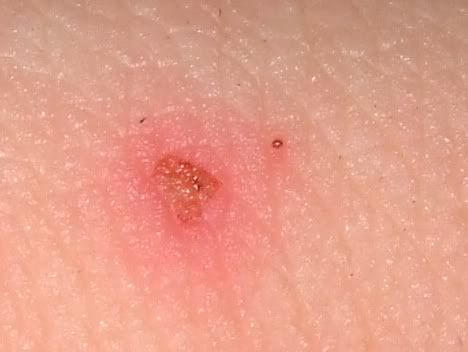
The tarantula is a spider of the steppes and deserts that lives in depressions, sometimes reaching up to one meter. It is almost impossible to meet a tarantula during the day, as it is a purely nocturnal predator. The notorious danger of the tarantula, first of all, concerns insects, which the spider prefers to feed on. In humans, a tarantula spider bite causes pain and a burning sensation at the site of injury. Tarantula bites are extremely rare and not poisonous, but an angry spider can shed needle-like hairs that get into the skin or eyes as foreign bodies and can cause mast cell degranulation and a pseudo-anaphylactic reaction (e.g. urticaria, Quincke's edema, bronchospasm, arterial hypotension) in sensitive people, usually spider owners who come into contact with them daily.
Local swelling develops, a small rash may form around the wound. The bite of a large tarantula is accompanied by hyperthermia, headache, paresthesia, and general weakness. A fatal outcome is extremely rare and is associated with a general allergic reaction to toxins and anaphylactic shock. A simple bite of a tarantula spider disappears without a trace within 3-5 days.
Tarantula bite
A tarantula spider bite does not pose a mortal danger to humans. Considering that the new fashion for breeding these spiders as pets is becoming widespread, many owners have already “tested” a tarantula attack, and all of them remained alive and well. Seeking medical attention after a bite is more likely to be a precaution or due to ignorance of the properties and abilities of your pet. The tarantula spider is dangerous to small animals in the wild. The tarantula hunts frogs, lizards, and small birds. The spider’s venom does not kill the victim, but only paralyzes it, since it is a neurotoxic substance. A tarantula spider bite can also be used as self-defense, which is the reason for an attack on humans. A tarantula pet most often bites its owner “dry,” meaning it does not release venom, but only damages the skin. Mechanical damage to the skin is relatively dangerous in terms of bacterial infection. This danger can be eliminated quite easily by treating the wound with an antiseptic.
Karakurt spider bite
The bite of a black widow spider can be deadly for both humans and animals. In the wild, the black widow feeds mainly on small insects. The black widow will not attack a person on its own; it will only bite if it is disturbed or stepped on. The most poisonous are the female black widows, which emit a strong poison that causes atrophy and gangrene of soft tissues.
Also, the bite of the karakurt spider can be accompanied by general intoxication of the body with a fatal outcome. The most characteristic symptoms are severe diffuse pain spreading throughout the body, chills and cold sweat, cyanosis of the skin, convulsions, suffocation, paresthesia, and possible coma. The reaction develops within a few hours, less often within 24 hours. The bite of the karakurt spider is dangerous due to its neurotoxic effect, paralyzing the human central nervous system.
Cross spider bite
Cross spiders are found everywhere, this is one of the most common types of arthropods in the world. The spider got its name due to the characteristic mark on its body - a cross-shaped pattern is clearly visible on the abdomen. The spider's coloring can vary depending on the environment - this is how the spider camouflages itself, waiting for its prey. The bite of a cross spider can be dangerous for many animals, since the poison contains temperature-resistant hemolysin (a substance that completely destroys red blood cells). However, not all animals are susceptible to this poison; large dogs, sheep, cows, and horses are resistant.
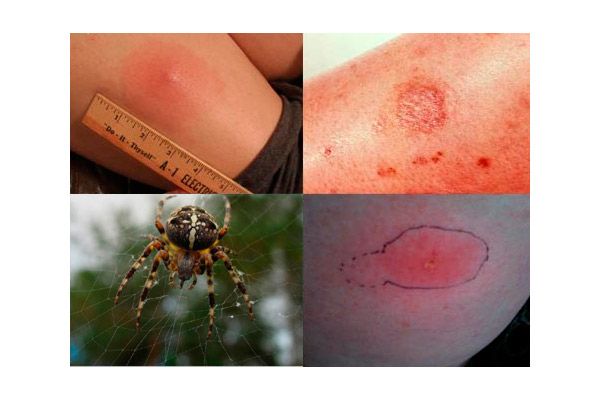
The bite of a cross spider does not pose a mortal threat to humans, but the appearance of a headache, aching joints, and burning can cause a lot of trouble for the bitten person. The epeirotoxin released by the spider is absorbed and excreted from the human body within 24 hours, the bite site may retain some swelling for several days.
Recluse Spider Bite
The bite of a recluse spider is extremely dangerous for both humans and animals. Recluse spiders are common mainly in the American states, as well as in Australia, where they were brought from the United States with transport cargo. A distinctive visual mark of a recluse is a pattern on its back, resembling a violin. These spiders are small in size, so people often do not even notice them in the house or in nature. Spiders prefer to hide in old boxes under cabinets, in cracks in walls and floors.
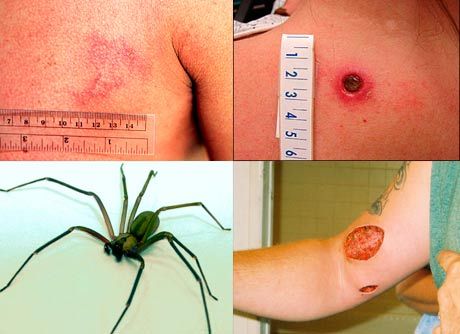
It is dangerous because it is practically invisible and does not cause even the slightest sensation of pain. Symptoms of damage develop only on the second day, when the poison has already spread throughout the body. Severe itching, compaction and visible swelling appear. Then the swelling ulcerates, soft tissues begin to necrotize (die). The ulcer is difficult to treat, necrosis affects very deep layers of the skin. In addition to external manifestations, the bite of a recluse spider is accompanied by typical flu symptoms - high temperature, aching joints, runny nose, cough and general weakness. Some cases of severe intoxication can disrupt the functioning of the kidneys, heart and lead to death.
House Spider Bites
The house spider is divided into several types - black, gray, brown and others. The most common type of house spider in everyday life is the black house spider - Badumna insignis, which prefers to live both inside and outside the home - in window frames, building walls, in logs or tree trunks, that is, wherever it will not be interfered with while weaving its web. House spider bites are extremely rare, a person must try very hard to get such an injury. If trouble does happen, the bite site really hurts, but the pain is bearable.
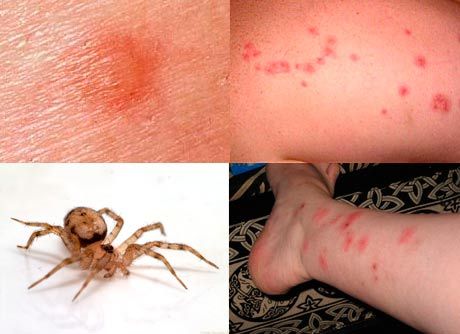
Also, a small swelling may develop in the area of microdamage, symptoms of dizziness, nausea and elevated body temperature are extremely rare. House spider bites do not cause severe intoxication, it is enough to apply ice or a cold compress to the puncture site, within 24 hours all traces usually disappear.
Consequences of a spider bite
The most dangerous consequences of a spider bite are tissue necrosis, wound infection, and arachnosis or loxoscelism, which most often develops after bites from recluse spiders. Arachnosis is characterized by rapidly developing necrosis of the skin, subcutaneous tissue, and nearby soft tissues. The consequences can also manifest as a life-threatening systemic syndrome, which begins as a fever, accompanied by diffuse myalgia, arthralgia, convulsions, a sharp drop in blood pressure, hemolysis, and heart failure.
Platelet hypercoagulability syndrome – DIC (disseminated intravascular coagulation) – is also a fairly common consequence of a black widow or hermit attack. The consequences can be summarized as follows:
Mild, non-threatening effects:
- Tolerable pain at the site of injury.
- Hyperemia of the skin.
- A small swelling in the puncture area.
- Itching, burning.
Effects felt within a week:
- Pain.
- Swelling and puffiness that do not go away within 3-5 days.
- Itching and redness.
- Digestive upset.
- Transient convulsions.
- Drowsiness and general malaise.
Consequences that are considered threatening:
- A sharp pain that spreads intensely throughout the body.
- A rapidly growing tumor.
- Generalized convulsions.
- Gastrointestinal upset, uncontrollable diarrhea.
- Constant drowsiness, weakness, explained by a steady decrease in blood pressure.
- Renal failure.
The consequences of a spider bite can be much less dangerous if timely and adequate assistance is provided.
Diagnosis of spider bites
Patients often mistakenly suspect a spider bite. Diagnosis is usually based on the patient's story and physical signs, but is rarely confirmed, as it requires witnesses to the bite, identification of the spider, and exclusion of other causes. The following conditions are distinguished that mimic a spider bite:
- bites of ants, fleas, bedbugs, ticks, flies and beetles;
- skin lesions [eg, toxic epidermal necrolysis, erythema chronicum migrans, erythema nodosum, sporotrichosis, herpes simplex chronicus, or periarteritis nodosa];
- infectious diseases (eg, disseminated gonorrheal infection, septic embolism due to endocarditis or intravenous drug abuse, cutaneous anthrax, skin abscess with methicillin-resistant Staphylococcus aureus);
- trauma (eg, subcutaneous injection of a drug, self-inflicted wounds);
- panic attack.
Severe cases of latrodectism may mimic appendicitis, rabies, or tetanus. The spider is identified by location and appearance. Black widow spiders live outdoors in sheltered areas (e.g., rock piles, wood piles, haystacks, buildings) and have a red or orange hourglass pattern on their abdomen. Brown spiders live indoors in sheltered areas (e.g., in clothing, behind furniture, under baseboards), and have a violin-shaped pattern on the dorsal side of the cephalothorax.
First Aid for Spider Bites
Help for spider bites should correspond to the type of poison and symptoms. It is not always possible to identify an arachnid, for example, a black widow spider, since signs of a puncture appear several hours later, when the spider has already disappeared. However, by determining the nature of the puncture by the appearance of the skin, it is possible to provide the necessary, adequate help for spider bites.
- A cold compress, preferably ice, should be placed on the puncture site.
- Children under 16 years of age and the elderly are subject to immediate hospitalization.
- When attacked by a black widow, a specific serum is administered intravenously. Before the administration of the agent, a skin test or fractional sensitization is performed for a more adequate perception of the serum by the body.
- It is advisable to carry out antihistamine therapy.
- In severe cases accompanied by cardiac or renal failure, cardiac drugs are administered, usually intravenously, respiratory analeptics, muscle relaxants and glucocorticosteroids.
- Conducting detoxification. It is carried out using infusion therapy (drip administration of saline solutions, glucose to maintain electrolyte balance).
- Necrotic tissues after a recluse spider bite are treated and removed. Treatment of necrotic ulcers is quite long and is usually performed on an outpatient basis.
First of all, first aid for spider bites should be timely, and the choice of method or sequence of actions depends on what kind of spider has bitten the person.
Spider Bite Treatment
Treatment is the same for bites by all spider species and includes wound debridement, analgesia, elevation of the limb, tetanus prophylaxis, and observation. These measures can successfully manage most local reactions. Ulcers should be treated daily; antibiotic ointments (eg, polymyxin B, bacitracin + neomycin) can be used. Ulcers are treated with antihistamines, topical glucocorticoids, or a combination of both. Necrotic lesions seen in brown spider bites are debridement and bandaged. In some cases, when necrotic areas are >2 cm in diameter, dapsone 100 mg orally once daily is prescribed until inflammation subsides, but its efficacy has not been fully proven. Local injection of glucocorticoids is of no use. Surgical excision, if necessary, should be delayed until the area of necrosis has been completely delineated (a process that may take weeks).
Systemic manifestations of black widow bites are initially treated symptomatically. Myalgia and muscle spasms from black widow bites respond poorly to muscle relaxants and narcotic analgesics. Slow intravenous administration of 2-3 ml of 10% calcium gluconate solution can rapidly relieve pain, but constant cardiac monitoring is necessary. Patients under 16 years of age or over 60 years of age with arterial hypertension and signs of severe poisoning should be hospitalized. Equine antidote is used in patients with severe latrodectism. It should be administered over 30 minutes; the reaction can have dramatic consequences. The dose for children and adults is the contents of 1 vial (6000 units) in 10-50 ml of 0.9% sodium chloride solution administered intravenously over 3-15 minutes. The manufacturer recommends skin testing before prescribing the antivenom, but these tests do not always predict adverse reactions (eg, acute anaphylaxis).
What to do if bitten by a spider?
If the bite caused by a black widow spider, a hermit spider, is examined in a timely manner and undergoes specific therapy, as a rule, rehabilitation after this is not required. However, due to severe general intoxication and weakening of the body, it will not be superfluous to strengthen the immune system and slightly support the organs and systems with vitamin therapy. In addition, gastrointestinal symptoms and diarrhea sometimes occur. In this case, it is worth following a gentle diet for two to three weeks, excluding protein foods. If the arachnid attack causes an allergic reaction, after the spider bite it is necessary to undergo a course of antihistamine therapy. Neurotoxic poison, which can cause functional disorders of the central nervous system, is removed with the help of drug therapy, as an independent action, plenty of fluids are indicated and bed rest is desirable. All actions aimed at eliminating the consequences should be adequate to the main symptoms.

If a child or an adult is bitten by a spider, and no one is immune from this, timely first aid can save not only the health, but sometimes even the life of the bitten person. Therefore, you should remember the proposed algorithm to know what to do if bitten by a spider:
- If the bite is not considered too dangerous, the area of injury should be washed with running water, preferably with soap, to avoid possible infection of the wound.
- The bitten limb should be immobilized to reduce the possibility of the poison spreading.
- The leg or arm can be bandaged with an elastic bandage or material just above the bite site. This localizes the area of poison spread. The bandage should not be too tight so as not to disrupt the general blood supply to the limb.
- A cold compress, preferably ice, should be applied to the puncture site.
- What to do if bitten by a spider, knowing that it is intoxication of the body? Of course, drinking plenty of fluids will help, which will speed up the elimination of toxins.
- If symptoms are mild, such as headache and slight fever, you can take paracetamol.
- If a mild allergic reaction occurs, you can take an over-the-counter antihistamine - Allergostop, Loratadine, Agistam.
What to do if you are bitten by a spider and the symptoms are alarming? The answer is clear - emergency medical care or immediate independent medical attention. It is especially worth hurrying in the following cases:
- If a spider has bitten a child (under 16 years of age).
- The symptoms of the bite develop rapidly, and the condition worsens sharply.
If you know (or suspect) that the bite was caused by a black widow spider or a brown recluse spider. Treatment for these bites requires the administration of a serum (antidote).

